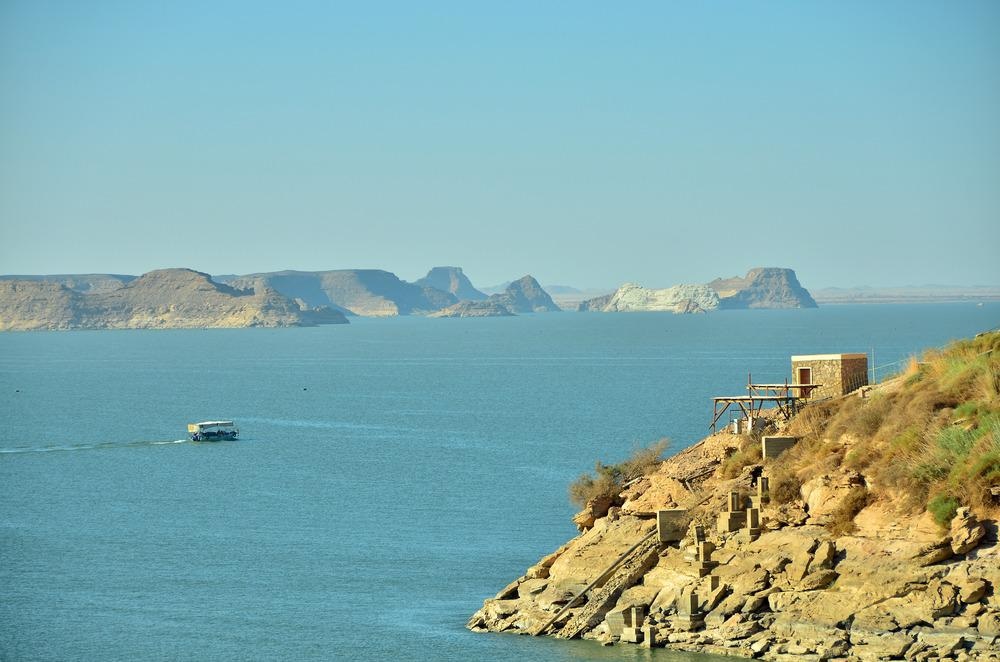People who lived near the Nile river migrated to central Egypt 10,000 years ago, despite the fact that the Egyptian Sahara was still green. Geologists led by the University of Geneva (UNIGE), Switzerland, explore the fossil rivers north of Lake Nasser in Egypt to reconstruct the palaeo-hydrology of the region and establish the rainfall rate of this humid African era.

Image Credit: Elzbieta Sekowska/Shutterstock.com
Researchers found a temperature rise of around 7°C along with a fourfold increase of rainfall events. River floods also forced nearby residents to move inwards towards the center of the country. These findings can be read in the journal Quaternary Science Reviews, and they highlight the increase in extreme weather occurrences in the event of global warming.
Between 14,800 and 5,500 BC Africa experienced a long period of wet weather, marked by a still green Sahara. Nevertheless, this region north of Lake Nasser in Egypt is currently arid, leaving only fossilized rivers as hints of this green past.
These rivers are essential for reconstructing past climates, as they allow us to determine the quantities of flowing water at the time, as well as the quantities and frequencies of rainfall.
Abdallah Zaki, Study First Author and PhD Researcher, Department of Earth Sciences, Faculty of Science, UNIGE
Reconstructing River Discharge to Obtain Precipitation Rates
To rebuild the palaeo-hydrology of a region, pebbles in the fossil rivers were measured.
Sébastien Castelltort, the study's final author commented, "Large pebbles indicate a high water discharge, capable of transporting them, as do the depth and width of the river, which make it possible to assess the water discharge, for instance in units of cubic meters per second."
Second, the surface area of the drainage basin, i.e., the region that links the water upstream to the river must be figured out.
“By combining these two figures, we obtain the precipitation rate responsible for transporting the studied sediments”, continues the Geneva scientist.
To uncover the river's age, researchers employed two different methods. The first, conducted together with ETH Zurich, uses carbon-14 dating of the organic matter covering fossilized rivers. The second, known as Optically Stimulated Luminescence, was conducted together with experts from the University of Lausanne, consists of quantifying the luminescence of quartz to find the sediment deposit's age.
A Sharp Increase in Intense Rainfall
The researchers explored six rivers in the region and established that the rivers were largely active between 13,000 and 5,000 BC, i.e. at the peak of the African wet era.
Abdallah Zaki, Study First Author commented, "But what is particularly interesting is that our study shows that the rainfall was very intense, with rates of 55-80 mm per hour, and that such rainfall events were 3 to 4 times more frequent than before the African humid period, which is an enormous climate perturbation."
Undeniably, the rainfall rate per year alone does not reflect the rains' amount.
If we take London as an example, we have the impression that it rains all the time. However, London sees an average of 680 mm of rain per year, compared to about 1400 mm in Geneva, which is more than twice as much!
Sébastien Castelltort, Study Final Author and Associate Professor, Department of Earth Sciences, UNIGE
In London, rainfall is spread across the entire year, whereas it is more concentrated in Geneva.
An Explanation for the Strong Migration of the Nile Populations
The results gathered by the geologists, including the unexpected increase in the frequency of strong rainfall events, could explain the high migration of the region's people who resided near the river, as perceived by the archaeologists.
“Indeed, the violent flooding of the rivers increased, making the banks inhospitable”, confirms Abdallah Zaki.
The fourfold surge in intense rainfall also correlates with a 7°C increase in temperature in the region.
This study thus provides us with a historical lesson told by the rocks on how the Earth system behaves in the event of rapid global warming.
Sébastien Castelltort, Study Final Author and Associate Professor, Department of Earth Sciences, UNIGE
At present, comprehending the distribution of precipitation across the year will become an essential issue in risk prevention as the threat of global warming looms in the near future.“What happened in Germany this summer will certainly become more common”, he concludes.
Journal Reference:
Zaki, A.S., et al. (2021) Did increased flooding during the African Humid Period force migration of modern humans from the Nile Valley? Quaternary Science Reviews. doi.org/10.1016/j.quascirev.2021.107200.